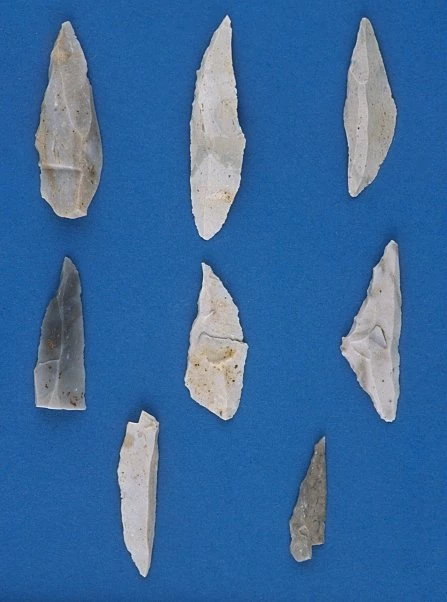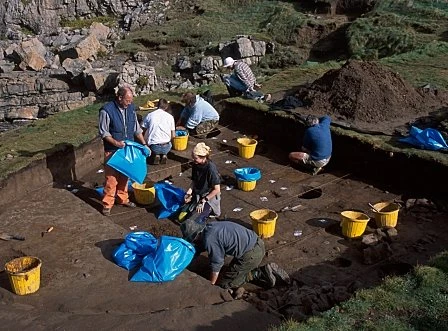Hunting for food in the Stone Age
Microliths from Burry Holms, Gower. Each microlith illustrated here is less than 50mm (2 inches) long. Microliths were widely used across Europe during the Middle Stone Age, or Mesolithic. This period dates from the end of the Ice Age (about 9200BC) until the introduction of agriculture to Wales (4000BC).
Microlith showing an impact fracture across its tip (top of image). This damage may have been caused during hunting.
Excavations at Burry Holms
Microliths
9,000 years ago one of the most important tools in the search for food were microliths - barbs made of stone that made a big impact on life in the Middle Stone Age.
From 9200-4000BC (during the Mesolithic or Middle Stone Age) people in Wales lived by hunting, fishing and gathering edible plants. Harpoons and spears were common tools and these carried stone barbs (microliths) that could inflict a deep cutting wound on prey.
Microliths, were made from flint blades each carefully crafted to make a sharp point. Individually a microlith is too small to do any real damage, but when two rows of these are glued into a spear's shaft they make an effective tool.
Between 1923 and 2001 over eighty microliths have been discovered on Burry Holms, today a tidal island on the north-western tip of Gower (a peninsula in south Wales). Here a band of hunter-gatherers spent part of the year hunting red deer, gathering nuts and fishing in the nearby rivers.
Burry Holms
The soils at Burry Holms do not preserve the wooden or bone hafts of these hunters' tools, but even so, the microliths that survived have some interesting stories to tell.
Several of the microliths unearthed at Burry Holmes have snapped at their tip, possible evidence of where they struck an animal during a hunt, breaking from the impact. In constrast, the missing tips of these microthiths have been discovered seperately, showing markings of once being in a fire.
It is possible that a flint microlith had done its work in killing a red deer and that its tip survived in the meat when it was cooked and eaten - perhaps this was the ancient equivalent of finding lead shot in a rabbit pie!
Background Reading
'Burry Holms (SS40019247)' by E. A. Walker. In Archaeology in Wales, vol. 40, p88-89 (2000).
'Burry Holms (SS40019247)' by E. A. Walker. In Archaeology in Wales, vol. 41, p126 (2001).
Late Stone Age Hunters of the British Isles by C. Smith. Published by Routledge (1992).



Comments - (14)
i will fail